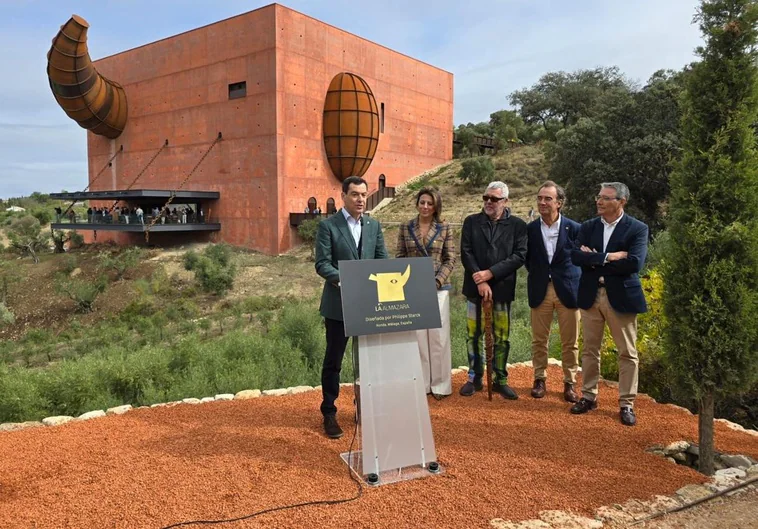
Philippe Starck's organic olive oil mill experience in Ronda is now a reality
Now open to the public, this avant-garde building, designed by the Frenchman and commissioned by LA Organic and its backers, is dedicated to the liquid gold and Ronda with past and present intertwined into an experience for all the senses
About a decade after the idea was first conceived, French designer Philippe Starck's organic olive oil mill in Ronda is now a reality. This Friday the museum, dedicated to the history and production of extra virgin olive oil (EVOO) and with a nod, among others, to bullfighting, Pedro Romero and Abbas Ibn Firnas, opened to the public.
The cube, nicknamed as such for its shape (or the bull as Starck calls it, given that its façade sports a large horn, among other features), is located next to the main road between Ronda and Cuevas del Becerro, around two kilometres from Ronda.
The overall project has involved an investment of 22 million euros and consists of the olive oil mill and a tour of the estate among olive groves and vineyards that are dotted with various works by Starck. It also includes accommodation and other spaces for holding events and oil tastings, among other activities.



It is the olive oil company LA Organic, with origins in Ronda, which has launched this project together with associated investors including the Villar Mir family. The intention is that the mill, created as the only one of its kind in the world, will welcome around 40,000 visitors a year. They will be able to learn how EVOO (AOVE in Spanish) is produced and witness the steps involved in its production.
The inauguration this Friday was attended by Starck himself, the president of LA Organic Juan Villar Mir, who replaces Pedro González de Baeza, who recently passed away, Junta president Juan Manuel Moreno Bonilla, regional minister for the economy Carolina España, the Junta's provincial delegate for agriculture Fernando Fernández Tapia-Ruano, president of Malaga's provincial council Francisco Salado, provincial deputy for the economy María del Carmen Martínez, Ronda's mayor María de la Paz Fernández and her first deputy mayor Jesús Vázquez, as well as the managing director at LA Organic, Santiago Muguiro.
"He asked me to create something from out of the EVOO and my passion emerged," said Starck, who spoke of this liquid gold as "a sacred matter" and added: "What would Andalucía be without a bull?", making the case for his design.
Juan Villar Mir wanted to pay special tribute to Pedro González de Baeza, of whom he said that the mill was his dream. "The mill is a milestone in Ronda. It is a before and after in the future of tourism in Ronda," he said.
For his part, Juanma Moreno declared that this mill "projects culture, gastronomy, art and history" and that "it makes olive oil a product of excellence and innovation and links oil to tourism". The president of the regional government encouraged a commitment to rural tourism, as it is "a thriving sector in Andalucía".
"These are the projects that the province of Malaga needs, projects that invite you to visit it," Salado said emphatically.
Here's how it looks...
This olive mill, which has a bull's horn, the famous eye of Picasso and a large olive among other design elements on its façade, has been inspired by the Marqués de Riscal wineries designed by Frank O. Gehry (of Guggenheim Museum, Bilbao, fame), but taking the project from the world of wine to the world of olive oil.
The visit begins on the first floor of the building, where there is an exhibition area that tells the history of olive oil, its importance and its link with the land, with panels and videos and a display of various pieces related to the industry.
There are also references to Ronda's culture and a large-format painting of Pedro Romero as originally painted by Goya. The bullfighting references continue with a sword on one of the walls of the cube and a large tube, shaped like a bull's horn, which ends in a hopper on the first floor through which visitors can see how the olives are arrive for processing. Down in the basement, all set up with see-through panels, is where the machinery for making the liquid gold now operates.
Also on display is a large-format, AI-generated portrait (few images in his time) of Abbás Ibn Firnás, a scientist from Ronda who flew with a device he built himself some 600 years before Leonardo Da Vinci. He is considered the father of aviation. Thanks to the collaboration of Antonio Acedo del Olmo, who supported this work, the contraption with which this wise man flew for ten minutes has been recreated.
On the first floor there is the oil mill, which has another bull's horn on the ceiling and a large canvas by Starck's daughter, with a farmer, birds, Ronda's Puente Nuevo (its most famous, gorge-spanning bridge) and the bullring, among others. Also there is the restaurant, shop, a multi-purpose room and a large cantilevered terrace with views of the landscape that is held up by old anchor chains from ships. In the centre of this floor is the aforementioned hopper. There are two chimneys and the smoke will exit through Picasso's eye leaving its mark, something Starck wanted to capture.
This olive oil mill is the Frenchman's third creation in Spain, following his commissions in Puerto Adriano in Mallorca and La Alhóndiga (Azkuna Zentroa in Basque) in Bilbao.
